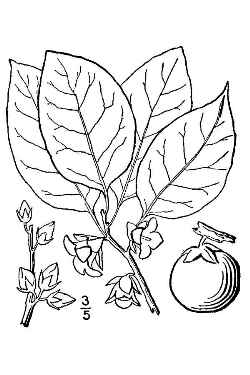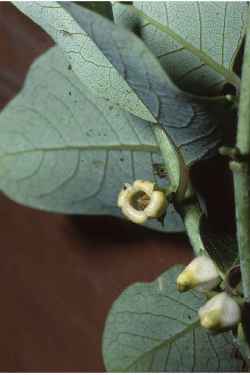
Diospyros virginiana, leaf and bark, picture by Robert H. Mohlenbrock. USDA NRCS. 1995. Northeast wetland flora: Field office guide to plant species.
Sunset®: 3-9,14-16,18-23
USDA: 4-9
Sun Exposure: Full sun
Origin: Southern USA
Growth Habits: Small to medium-sized tree 20 to 50 feet tall (6-15 m), 20 to 35 feet spread (6-10 m); leaves lustrous dark green above
Flowers: White or greenish flowers
Watering Needs: Moderate water
Propagation: Root cuttings and grafting, seeds
Propagation: Seed
- by seeds, in spring. Germinates at 70-85 degrees F. The seeds can be harvested in autumn. The seeds need stratify 40F 2-3mo.. The usual germination temperature is 70-85 degrees F.

Diospyros virginiana, Britton, N.L., and A. Brown. 1913. Illustrated flora of the northern states and Canada. Vol. 2: 720.

Diospyros virginiana, flowers, picture by Robert H. Mohlenbrock. USDA NRCS. 1995. Northeast wetland flora: Field office guide to plant species.
Blooming Habits:
Usually dioecious, inconspicuous white to greenish-white flowers, from March to June. The male flowers are in 3's, 0.3 to 0.5 inch long (8-12 mm), while the female flowers are solitary, slightly larger, 0.5 to 0.8 inch long (1.2-2 cm).
Fruiting Habits:
A green plum-like spherical berry turning orange to black when ripe, 0.8 to 2 inches in diameter when ripe (2-5 cm). The fruit is very astringent if not fully ripe, very sweet and edible when soft and ripe in September to November. Contrarily to a common concept, frost is not needed for the fruit to soften. The persimmon doesn't bear fruit until at least 10 years old. The fruits are born only to the female trees, if there is a male tree in the proximity.
Culture:
The trees are difficult to transplant because of their deep tap root.
Desert-Tropicals is dedicated to provide gardening advice, gardening ideas, and information about flower of all kind for landscape and collections.We try to check carefully the identification of the plants on the illustrations as well as the other information from the page, but occasionally errors do occur. if you notice anything that needs to be changed please contact us.Thanks.
© 1998-2020 Philippe Faucon, All Rights Reserved.